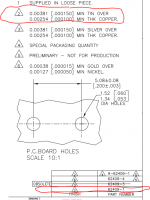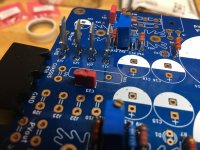This is one of the few parts that I solder it from the top side first. No dripping problem - maybe that is the trick to applying a lot of heat?
Of course - a great idea! 🙂
I will do that, going forward.
Andy
I just noticed something when I tried to use cheap no-name spade terminals (probably bought from Aliexpress years ago). They would not take on the solder easily and got all gunked up with burnt up flux yet the solder would not stick. I removed it and used a genuine TE Connectivity AMP Faston brand spade terminal. These are precision made with thick solid copper core and silver plated. They heat up instantly with my soldering iron and the solder wet the part and the pads and flowed nicely. Huge difference. If you notie difficulty soldering the spade tabs, I can highly recommend genuine Faston brand. $0.17ea but well worth it.
62409-1 TE Connectivity | Mouser
CAD drawing showing material composition (copper with silver plating):
https://www.te.com/commerce/Documen...cLang=English&PartCntxt=62409-1&DocFormat=pdf
62409-1 TE Connectivity | Mouser
CAD drawing showing material composition (copper with silver plating):
https://www.te.com/commerce/Documen...cLang=English&PartCntxt=62409-1&DocFormat=pdf
I buy these as well and have no problems.
Unfortunately according to the hard to read data sheet the silver plating (3) is obsolete (bottom right hand corner).
Also in one area of the data sheet it says the material is brass and in another it says copper.😱
Unfortunately according to the hard to read data sheet the silver plating (3) is obsolete (bottom right hand corner).
Also in one area of the data sheet it says the material is brass and in another it says copper.😱
If you match the 62409-1 part number it matches silver and copper. I cut one open and it’s copper not brass. The coating looks to be silver from the color. Not Sn. The Sn ones turn copper colored when heated too long. The silver ones stay silver.
I hope you're right because the data sheet, if I'm reading correctly says tin for 62409-1.
Attachments
Last edited:
Would there be any benefit using this for a Class AB amp other than that a soft start wouldn't be needed?
Or, could just the main portion be used and the capacitance multiplier section be bypassed, to really minimize power loss to the greatest possible extent?
Or, could just the main portion be used and the capacitance multiplier section be bypassed, to really minimize power loss to the greatest possible extent?
Last edited:
The active bridge is a nice feature that really makes the power from the transformer as noise free as possible. For Class AB amp with high PSRR, the cap multiplier is not really needed.
You may be better off getting a traditional CRC PSU and use an LT4320 active bridge to feed it. Variants of this can be found on Prasi’s thread for LT4320 active bridges.
You could bypass the cap Mx on the SLB and do the same thing if you want. Kind of a waste of capability though.
You may be better off getting a traditional CRC PSU and use an LT4320 active bridge to feed it. Variants of this can be found on Prasi’s thread for LT4320 active bridges.
You could bypass the cap Mx on the SLB and do the same thing if you want. Kind of a waste of capability though.
Huh, you're right. I didn't see prasi's thread there.The active bridge is a nice feature that really makes the power from the transformer as noise free as possible. For Class AB amp with high PSRR, the cap multiplier is not really needed.
You may be better off getting a traditional CRC PSU and use an LT4320 active bridge to feed it. Variants of this can be found on Prasi’s thread for LT4320 active bridges.
You could bypass the cap Mx on the SLB and do the same thing if you want. Kind of a waste of capability though.
What is it about the SLB that negates the need for a separate soft start?
You still need a soft start to prevent current in rush to charge the trafo when you power up. I don’t think I said anywhere that a soft start would not be needed. That’s why we came up with the soft as a feather pillow SFP soft start circuit. It uses SSR’s so nothing to wear out compared to mechanical relays.
You still need a “softstart” for the inrush of current hitting the primary side of the transformer. The SLB doesn’t help that.
Post #1 in this thread:You still need a soft start to prevent current in rush to charge the trafo when you power up. I don’t think I said anywhere that a soft start would not be needed. That’s why we came up with the soft as a feather pillow SFP soft start circuit. It uses SSR’s so nothing to wear out compared to mechanical relays.
xrk971 said:7. As icing on the cake, the SLB provides a smooth slow ramp up to prevent mains current overload and tripping fuses, plus, it eliminates turn on speaker pop.
Alright, well, if the transformer is not that big I'd be OK with that. Especially since the total capacitance would typically be relatively small due to the cap multiplier.You still need a “softstart” for the inrush of current hitting the primary side of the transformer. The SLB doesn’t help that.
Yes, sorry about the mixed message - the cap mulitplier provides a softer ramp up voltage to the amp, and in some cases, this slower rise can prevent speaker thump at turn on. However, it doesn't do anything for the surge created by the large transformer in rush current. I will edit post 1 to make that more clear. To really stop turn on thump, the RTR SSR speaker protection with turn on delay is the best way to take care of that.
You still need a “softstart” for the inrush of current hitting the primary side of the transformer. The SLB doesn’t help that.
But surely the 8D-20 in series with the active input to the power traffo does that, V?
Andy
Yes, if your not utilizing a softstart module, the NTC (8D-20) in series with the trafo primary winding will soften the hit. The downside to that option is heat and sacrificing a couple of AC volts.
Yes, if your not utilizing a softstart module, the NTC (8D-20) in series with the trafo primary winding will soften the hit. The downside to that option is heat and sacrificing a couple of AC volts.
Aah, I didn't know that it reduced the voltage going into the traffo when it had warmed up.
But that's absolutely what I need - as I was getting 22v out from the SLBs when I tested them (without an 8D-20 in place). As my 4R ANs will be driving 3.2 ohm Maggie mid panels and 2 ohm Maggie ribbons - ie. below the nominal 4 ohm spec - I was not keen on upping the DC rails from 20v to 22v.
So it looks like the 8D-20s will do what I need! 🙂
Andy
- Home
- Group Buys
- The SLB (Smooth Like Butter) Active Rect/CRC/Cap Mx Class A Power Supply GB

